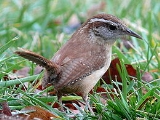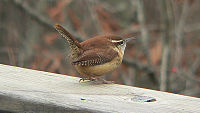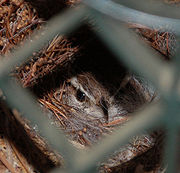
Carolina Wren
Encyclopedia
The Carolina Wren is a common species
of wren
, resident in the eastern half of the USA, the extreme south of Ontario
, Canada
, and the extreme northeast of Mexico
. A distinct population in the Yucatan
Peninsula of Mexico, Belize
and extreme north of Guatemala
is treated either as a subspecies
Thryothorus ludovicianus albinucha, or as a separate species, White-browed Wren Thryothorus albinucha. Following a 2006 review, these are the only wrens remaining in the genus
Thryothorus. T. ludovicianus is the state bird
of South Carolina
; its specific name ludovicianus means "from Louisiana
".
 Typically 14 cm long (6–7 in) and about 20 g in weight, it is a fairly large wren; among the United States species it is second largest after the Cactus Wren
Typically 14 cm long (6–7 in) and about 20 g in weight, it is a fairly large wren; among the United States species it is second largest after the Cactus Wren
. The upperparts are rufous brown, and the underparts a strong orange-buff, usually unmarked but faintly barred on the flanks in the southwest of the range. The head has a striking pure white supercilium (eyebrow) and a whitish throat. The race albinucha is duller brown above and has additional white streaking on the head.
It is easiest to confuse with the Bewick's Wren
, a fairly close relative, which differs in being smaller but with a longer tail, grayer-brown above and whiter below. The Carolina and White-browed Wrens differ from the House Wren
in being larger, with a decidedly longer bill
and hind toe; their culmen has a notch behind the tip.
. The songs vary regionally, with birds in northern areas singing more slowly than those in southern areas.
The Carolina Wren also has a series of calls, including a rapid series of descending notes in a similar timbre to its song, functioning as an alarm call, and a very harsh and loud scolding call made to threaten intruders.
Populations in Canada and the northern half of the US experience regular crashes following severe winters, but their high breeding productivity soon results in a return to higher numbers. These birds are generally permanent residents throughout their range and defend territory year round; some birds may wander north after the breeding season.
They eat insect
s, found in leaf litter or on tree trunks; they may also eat small lizard
s or tree frog
s. In winter, they occasionally eat seeds, berries, and other small fruit
s.

Females typically lay between four to six eggs (normally over a period of several days) up to three times per year (but normally only twice). Eggs are oval, grayish-white and sprinkled with reddish-brown spots. Incubation is performed by the female only and lasts anywhere from 12–14 days, with the first young leaving the nest 12–14 days after hatching. Chicks hatch bald and blind, and depend upon parents until fledging. Both the male and female feed the young. They only brood for a short period of time after hatching, leaving the young in a warm, down-lined nest while adults search for food. If conditions are right, the same nest may be used more than once.
If you are interested in attracting these wrens to nesting spots around your house, a hanging flowerpot, or any moderately deep receptacle. An upside-down tomato hanger works perfectly, provided that you fill it with dirt, leaving 5 to 7 inches of empty space between the top of the dirt and the top opening of the hanger, then line the top of the dirt with dry grass or straw. During cold winter nights, add several handfuls of dry grass (not straw, which is too coarse and prickly) into the receptacle, and the wrens will use these same sites to roost in, by burrowing into the grass to keep warm. Alternatively, you can leave the last nest of summer through winter, and the birds will roost in it.
Aside from the above-mentioned foods, you can attract them to your yard year-round with raw, crunched-up peanuts, or suet cakes of nuts and berries (found at most supermarkets and pet stores).
Species
In biology, a species is one of the basic units of biological classification and a taxonomic rank. A species is often defined as a group of organisms capable of interbreeding and producing fertile offspring. While in many cases this definition is adequate, more precise or differing measures are...
of wren
Wren
The wrens are passerine birds in the mainly New World family Troglodytidae. There are approximately 80 species of true wrens in approximately 20 genera....
, resident in the eastern half of the USA, the extreme south of Ontario
Ontario
Ontario is a province of Canada, located in east-central Canada. It is Canada's most populous province and second largest in total area. It is home to the nation's most populous city, Toronto, and the nation's capital, Ottawa....
, Canada
Canada
Canada is a North American country consisting of ten provinces and three territories. Located in the northern part of the continent, it extends from the Atlantic Ocean in the east to the Pacific Ocean in the west, and northward into the Arctic Ocean...
, and the extreme northeast of Mexico
Mexico
The United Mexican States , commonly known as Mexico , is a federal constitutional republic in North America. It is bordered on the north by the United States; on the south and west by the Pacific Ocean; on the southeast by Guatemala, Belize, and the Caribbean Sea; and on the east by the Gulf of...
. A distinct population in the Yucatan
Yucatán
Yucatán officially Estado Libre y Soberano de Yucatán is one of the 31 states which, with the Federal District, comprise the 32 Federal Entities of Mexico. It is divided in 106 municipalities and its capital city is Mérida....
Peninsula of Mexico, Belize
Belize
Belize is a constitutional monarchy and the northernmost country in Central America. Belize has a diverse society, comprising many cultures and languages. Even though Kriol and Spanish are spoken among the population, Belize is the only country in Central America where English is the official...
and extreme north of Guatemala
Guatemala
Guatemala is a country in Central America bordered by Mexico to the north and west, the Pacific Ocean to the southwest, Belize to the northeast, the Caribbean to the east, and Honduras and El Salvador to the southeast...
is treated either as a subspecies
Subspecies
Subspecies in biological classification, is either a taxonomic rank subordinate to species, ora taxonomic unit in that rank . A subspecies cannot be recognized in isolation: a species will either be recognized as having no subspecies at all or two or more, never just one...
Thryothorus ludovicianus albinucha, or as a separate species, White-browed Wren Thryothorus albinucha. Following a 2006 review, these are the only wrens remaining in the genus
Genus
In biology, a genus is a low-level taxonomic rank used in the biological classification of living and fossil organisms, which is an example of definition by genus and differentia...
Thryothorus. T. ludovicianus is the state bird
State bird
A state bird is the insignia of a state .See also:* List of Australian bird emblems* List of Brazilian state birds* List of Canadian provincial birds* List of Chinese provincial birds* List of Indian state birds...
of South Carolina
South Carolina
South Carolina is a state in the Deep South of the United States that borders Georgia to the south, North Carolina to the north, and the Atlantic Ocean to the east. Originally part of the Province of Carolina, the Province of South Carolina was one of the 13 colonies that declared independence...
; its specific name ludovicianus means "from Louisiana
Louisiana
Louisiana is a state located in the southern region of the United States of America. Its capital is Baton Rouge and largest city is New Orleans. Louisiana is the only state in the U.S. with political subdivisions termed parishes, which are local governments equivalent to counties...
".
Description

Cactus Wren
The Cactus Wren is a species of wren that is native to the southwestern United States southwards to central Mexico.-Description:...
. The upperparts are rufous brown, and the underparts a strong orange-buff, usually unmarked but faintly barred on the flanks in the southwest of the range. The head has a striking pure white supercilium (eyebrow) and a whitish throat. The race albinucha is duller brown above and has additional white streaking on the head.
It is easiest to confuse with the Bewick's Wren
Bewick's Wren
The Bewick's Wren is a wren native to North America. At about 14 cm long, it is grey-brown above, white below, with a long white eyebrow. While similar in appearance to the Carolina Wren, it has a long tail that is tipped in white. The song is loud and melodious, much like the song of other...
, a fairly close relative, which differs in being smaller but with a longer tail, grayer-brown above and whiter below. The Carolina and White-browed Wrens differ from the House Wren
House Wren
The House Wren, Troglodytes aedon, is a very small songbird of the wren family, Troglodytidae. It occurs from Canada to southernmost South America, and is thus the most widely distributed bird in the Americas. It occurs in most suburban areas in its range and it is the single most common wren...
in being larger, with a decidedly longer bill
Beak
The beak, bill or rostrum is an external anatomical structure of birds which is used for eating and for grooming, manipulating objects, killing prey, fighting, probing for food, courtship and feeding young...
and hind toe; their culmen has a notch behind the tip.
Song and calls
The Carolina Wren is noted for its loud song, popularly rendered as "teakettle-teakettle-teakettle". This song is rather atypical among wrens. A given bird will typically sing several different songs. Only the male birds sing their loud songBird song
Bird vocalization includes both bird calls and bird songs. In non-technical use, bird songs are the bird sounds that are melodious to the human ear. In ornithology and birding, songs are distinguished by function from calls.-Definition:The distinction between songs and calls is based upon...
. The songs vary regionally, with birds in northern areas singing more slowly than those in southern areas.
The Carolina Wren also has a series of calls, including a rapid series of descending notes in a similar timbre to its song, functioning as an alarm call, and a very harsh and loud scolding call made to threaten intruders.
Ecology
The Carolina Wren is sensitive to cold weather. Since they do not migrate and stay in one territory the northern populations of Carolina wrens decrease markedly after severe winters. Because of this sensitivity to weather, gradually increasing temperatures over the last century may have been responsible for the northward range expansion seen in the mid-1900s.Populations in Canada and the northern half of the US experience regular crashes following severe winters, but their high breeding productivity soon results in a return to higher numbers. These birds are generally permanent residents throughout their range and defend territory year round; some birds may wander north after the breeding season.
They eat insect
Insect
Insects are a class of living creatures within the arthropods that have a chitinous exoskeleton, a three-part body , three pairs of jointed legs, compound eyes, and two antennae...
s, found in leaf litter or on tree trunks; they may also eat small lizard
Lizard
Lizards are a widespread group of squamate reptiles, with nearly 3800 species, ranging across all continents except Antarctica as well as most oceanic island chains...
s or tree frog
Tree frog
Hylidae is a wide-ranging family of frogs commonly referred to as "tree frogs and their allies". However, the hylids include a diversity of frog species, many of which do not live in trees, but are terrestrial or semi-aquatic.-Characteristics:...
s. In winter, they occasionally eat seeds, berries, and other small fruit
Fruit
In broad terms, a fruit is a structure of a plant that contains its seeds.The term has different meanings dependent on context. In non-technical usage, such as food preparation, fruit normally means the fleshy seed-associated structures of certain plants that are sweet and edible in the raw state,...
s.

Reproduction
These birds prefer sites with dense undergrowth, either in mixed forests or in wooded suburban settings, in a natural or artificial cavity. The nest is a bulky, often domed structure, with a small hole towards the top. Nests of the more domestically-inclined wrens have been reported in a great variety of nooks and crannies in, about, or under buildings of various kinds, under bridges, or in holes in any structure such as a porch, fence-post, flowerpot, tree, house or barn. Almost any kind of receptacle may offer an acceptable nesting site. Pairs may mate for life.Females typically lay between four to six eggs (normally over a period of several days) up to three times per year (but normally only twice). Eggs are oval, grayish-white and sprinkled with reddish-brown spots. Incubation is performed by the female only and lasts anywhere from 12–14 days, with the first young leaving the nest 12–14 days after hatching. Chicks hatch bald and blind, and depend upon parents until fledging. Both the male and female feed the young. They only brood for a short period of time after hatching, leaving the young in a warm, down-lined nest while adults search for food. If conditions are right, the same nest may be used more than once.
If you are interested in attracting these wrens to nesting spots around your house, a hanging flowerpot, or any moderately deep receptacle. An upside-down tomato hanger works perfectly, provided that you fill it with dirt, leaving 5 to 7 inches of empty space between the top of the dirt and the top opening of the hanger, then line the top of the dirt with dry grass or straw. During cold winter nights, add several handfuls of dry grass (not straw, which is too coarse and prickly) into the receptacle, and the wrens will use these same sites to roost in, by burrowing into the grass to keep warm. Alternatively, you can leave the last nest of summer through winter, and the birds will roost in it.
Aside from the above-mentioned foods, you can attract them to your yard year-round with raw, crunched-up peanuts, or suet cakes of nuts and berries (found at most supermarkets and pet stores).
External links
- About the Carolina Wren
- Carolina Wren Information - USGS Patuxent Bird Identification InfoCenter
- Carolina Wren Species Account - Cornell Lab of Ornithology
- Carolina Wren Information - South Dakota Birds and Birding
- Carolina Wren at feeder in Southeastern Vermont - Picture link
- Carolina Wren (BirdHouses101.com)
- Stamps (for United StatesUnited StatesThe United States of America is a federal constitutional republic comprising fifty states and a federal district...
) - Carolina Wren videos on the Internet Bird Collection
- Carolina Wren photo gallery VIREO
- Carolina Wren Bird Sound

